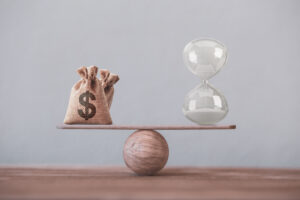IRA to IUL Conversion: Protect Retirement from Tax Hikes & Market Timing Disasters
Two invisible threats are silently eroding retirement accounts across America – future tax rate increases and the devastating impact of market downturns that occur right when you need your money most.
If you’re saving diligently in traditional IRAs or 401(k)s, you may think you’re on track for a secure retirement. But what happens when these qualified accounts become fully taxable during your retirement years – potentially at much higher tax rates than today?
Even worse, what if the market takes a significant downturn right as you begin your withdrawals? As our research demonstrates, the timing of market downturns can be just as destructive to your retirement as the downturns themselves – a concept known as “sequence of returns risk.”
In this comprehensive guide, we’ll explore how converting funds from a traditional IRA to a properly structured Indexed Universal Life (IUL) insurance policy creates a powerful dual defense system against these retirement threats:
- Protect against future tax increases through tax-free access to retirement funds
- Shield yourself from sequence of returns risk by having an alternative source of retirement income during market downturns
- Create tax-free legacy benefits for your loved ones that traditional retirement accounts simply can’t provide
Watch our eye-opening case study video below to see how devastating sequence of returns risk can be – and then continue reading to discover how an IRA to IUL conversion strategy might be the solution you haven’t been told about.
Table of Contents
- Introduction: The Tax Challenges of Traditional IRAs
- Sequence of Returns Risk: The Hidden Retirement Threat
- Funding Life Insurance with IRA Funds
- Life Insurance versus IRA for Retirement Savings
- Pros and Cons of Traditional IRAs
- ROTH IRA
- There May Be a Better Alternative for You
- Term Life vs Permanent Life Insurance
- Different Types of Permanent Life Insurance
- Funding Life Insurance with 401(k) Money
- Generating Retirement Income from Life Insurance and IRAs – A Comparison
- How to Put the Right Retirement Savings Plan in Place for Your Specific Objectives
Most people do not enjoy paying taxes. This is true both before and during retirement. But what many investors do not realize is that funds in traditional IRAs that grow on a tax deferred basis right now will eventually be taxed – and if future income tax rates are higher than they are today (as they are anticipated to be), these individuals will have done themselves a disservice with their retirement income planning. Unfortunately, realizing this at the time you’re starting to take withdrawals will be too late to do anything about it.
The good news is that there are strategies available that could help you to alleviate some – or possibly even all – of your income tax liability in retirement. These techniques – which involve converting traditional IRA funds to a properly structured life insurance policy – could also benefit your loved ones in the future from a tax standpoint, as well.
Sequence of Returns Risk: The Hidden Retirement Threat
Before diving into IRA-to-insurance conversions, it’s crucial to understand one of the biggest hidden threats to your retirement savings: sequence of returns risk. This risk factor, often overlooked by traditional financial advisors, can dramatically impact your retirement outcome even if your average returns look good on paper.
Sequence of returns risk refers to the timing of market downturns in relation to when you begin taking withdrawals from your retirement accounts. As demonstrated in our video case study of “Jack,” a retiree with $1 million in qualified retirement funds:
- When Jack retired during market downturns (1973-1974 period with -14% and -26% losses in the first two years), he ran completely out of money by age 86 despite taking only modest withdrawals.
- When Jack retired during positive market years (1982-1983 with +21% and +22% gains), he ended up with over $8.5 million at age 86 with the exact same withdrawal strategy.
The key insight: both scenarios had nearly identical average returns over the 25-year period, but the sequence of those returns made a multi-million dollar difference in the outcome.
This is where indexed universal life insurance (IUL) provides a powerful solution to complement your retirement strategy. By having an alternative source of tax-free income that’s not directly tied to market performance, you can:
- Avoid selling investments during market downturns
- Take tax-free loans from your IUL policy instead of taxable withdrawals from your IRA
- Preserve your qualified retirement accounts during recovery periods
- Dramatically improve your overall retirement outcome
The IRA-to-IUL conversion strategy we’ll explore below doesn’t just address future tax concerns—it also provides protection against this critical sequence of returns risk that threatens even well-funded retirement portfolios.
Case Study Insight: In our video demonstration, a retiree who implemented the IUL strategy and took withdrawals from the policy after market downturns retained $3.2 million in his retirement accounts at age 86—compared to running completely out of money without this strategy. All while contributing just $500 monthly to the IUL policy during his working years.
Funding Life Insurance with IRA Funds
An IRA to life insurance conversion is a process whereby an individual withdraws some or all of the funds in an Individual Retirement Account and then uses the net amount to purchase a permanent life insurance policy that builds cash value on a tax deferred basis. Later on, these same funds could be accessed tax free.
While funding life insurance with IRA funds presents numerous advantages, if it is not conducted properly, it could backfire, losing all of the tax-related benefits. So, before moving forward, it is critical to understand how an IRA to life insurance conversion works, and whether or not it is truly right for you and your objectives.
Life Insurance versus IRA for Retirement Savings
Contrary to what many people believe – including some financial and retirement planning professionals – life insurance can play a vital role in most any portfolio, both before and after retirement. This age-old asset can do far more than just pay out benefits upon the insured’s passing.
Cash value life insurance can be used for:
- Growing funds on a tax deferred basis
- Funding large purchases – including cars and college tuition
- Paying for health care and long-term care services
- Supplementing retirement income
- Accessing funds tax free (which can help to reduce or eliminate taxes on Social Security retirement benefits)
- Protecting against sequence of returns risk in your retirement portfolio
Because many people do not realize that cash value life insurance can be used in so many ways, investors tend to focus on other, more common retirement savings vehicles such as Individual Retirement Accounts (IRAs) and employer-sponsored savings plans like 401(k)s.
Traditional IRAs allow investors to contribute pre-tax funds to an account where the investments grow on a tax deferred basis. This tax deferral can allow the value of the account to grow exponentially – provided that the underlying investments perform well.
Each year, the IRS dictates a maximum amount that may be contributed to IRA accounts.
Roth IRA Income Limits (2024-2025)
| Filing Status | 2024 MAGI Limit | 2025 MAGI Limit |
|---|---|---|
| Single Filer | $161,000 | $165,000 |
| Married Filing Jointly | $240,000 | $246,000 |
Note: These figures represent the modified adjusted gross income (MAGI) limits above which you cannot contribute to a Roth IRA. Partial contribution amounts may be allowed at lower income levels.
Taxable Withdrawals
Regardless of how the investments in a traditional IRA perform, 100% of the withdrawals will be taxable. IRA withdrawals are taxable because none of the money – the contributions and the gain – has yet been subject to taxation. So, you could end up netting out far less in spendable income in retirement – especially in a high tax rate environment.
There is no way to protect all of the funds in a traditional IRA from this taxation, either, because the IRS requires you to start making withdrawals when you turn age 73. In addition, these required IRA withdrawals could also lead to the account becoming depleted far sooner than you had hoped, bringing about one of the causes for the biggest fear on retirees’ minds – running out of money while they still need it.
Penalties
If you don’t take your required minimum distributions – or even if you make a withdrawal, but the amount is less than the amount you are supposed to take out – you could also incur an IRS penalty. This penalty is a 25% tax on the amount that is not taken out of the account. (This penalty is down from its previous amount of tax on 50% of the non-withdrawn funds. But it is still considered quite steep).
You could also face an IRS penalty if you withdraw funds early from a traditional IRA. In this case, unless you qualify for an exception, if you access traditional IRA funds prior to turning age 59 ½, you’ll be hit with a 10% early withdrawal penalty. This is in addition to any taxes that you may owe.
Given all of the withdrawal taxes and potential penalties, along with the possibility of incurring investment losses, traditional IRA accounts may not be the best option for growing and protecting your retirement savings – or at least not all of it – nor for generating an ongoing income stream in the future. But the good news is that there are alternatives available.
THE ULTIMATE FREE DOWNLOAD
The Self Banking Blueprint
A Modern Approach To The Infinite Banking Concept

Pros and Cons of Traditional IRAs
| Traditional IRA Advantages | Traditional IRA Disadvantages |
|---|---|
| Pre-tax contributions | Withdrawals are 100% taxable (both the gains and the return of your contributions) |
| Tax deferred growth | Must take required minimum distributions (RMDs) starting at age 73 (in 2023) |
| Funds could be transferred to a Roth IRA or withdrawn and used for paying life insurance premium(s) | 10% IRS "early withdrawal" penalty if funds are accessed before you turn age 59 ½ |
| No income limits for participation | Has an annual maximum contribution limit |
ROTH IRA
One way to get around the taxable withdrawal hurdle of traditional IRAs is to open and fund a Roth IRA account. Roth IRAs have some similarities to traditional IRAs, as well as some significant differences.
For instance, contributions to a Roth IRA go in after tax. So, there is no income tax deduction for the year(s) that you contribute to a Roth. There are also income limits imposed for opening and funding Roth IRA accounts. So, if you are a higher income earner, you may not be able to take advantage of the tax free Roth IRA account.
Roth IRA Income Limits
IRA Annual Contribution Limits (2025)
| Age Group | Traditional IRA | Roth IRA |
|---|---|---|
| Under 50 | $7,000 | $7,000 |
| Age 50 and older (includes catch-up contribution) |
$8,000 | $8,000 |
Note: These contribution limits apply to the total contributions across all your IRA accounts (Traditional and Roth combined) for 2025.
However, there are some benefits that can come with owning a Roth IRA, including:
- Tax free growth of the funds in the account
- Tax free withdrawals – regardless of what the then-current income tax rates may be
- No required minimum distributions (RMDs) at any age
There may also be ways to get around the income limits and participate in a Roth IRA – regardless of how much money you make. A Roth IRA conversion entails taking some or all of the money in a traditional IRA and converting it to a Roth. Here, there is no limit on the amount of money you may transfer into the Roth account.
If you go this route, though, there are some important items to keep in mind. First, you will have to pay tax on any of the funds that are taken from the traditional IRA. In addition, because the money you move to the Roth IRA from the traditional IRA may count as income, the IRA conversion could put you into a higher tax bracket for the year in which the move takes place.
In any case, it is vital that you talk with a retirement income planning specialist before you move forward with any type of IRA conversion strategy. That way, you can know that you are going in the right direction, based on your particular objectives, time frame, and risk tolerance.
Pros and Cons of Roth IRAs
| Roth IRA Advantages | Roth IRA Disadvantages |
|---|---|
| Tax free growth | Has an annual maximum contribution limit |
| Tax free withdrawals | Could still face taxes and/or penalties on "early" withdrawals* |
| No required minimum distribution (RMD) rules | Income limits for opening and funding a Roth IRA account |
*Gains must be in the account for at least five years, and the account holder must be at least age 59 ½
 There May Be a Better Alternative for You
There May Be a Better Alternative for You
Although many investors have taken advantage of future tax free withdrawals and converted some or all of their traditional IRA funds into a Roth IRA, there is another option that a growing number of individuals are choosing – indexed universal life insurance. And there is a good reason for this.
Indexed Universal Life policies provide a number of enticing benefits, including:
- The power of indexing to grow funds securely
- Tax deferred growth of funds in the cash value component
- Tax free access to cash via policy loans
- Access to funds with no market value adjustments
- Protection against sequence of returns risk
- A tax-free legacy for loved ones
Because of this mix of benefits – features that are not all found together in other savings vehicles – indexed universal life has become a key component of holistic retirement and estate planning for a growing number of individuals and couples.
Because there are so many different types of life insurance policies available so it is important to first understand why an IUL policy may be a better alternative than the other types of permanent life insurance options for building up retirement savings and accessing funds for retirement in the future.
Term Life vs Permanent Life Insurance
The two primary categories of life insurance are term life and permanent life insurance, a/k/a cash value life insurance.
Term Life Insurance
Term life insurance, as the name suggests, only remains in force for a pre-set period of time (or “term.”) This could be as short as just one year (or even less), or as long as 30+ years. Because there is no cash value build-up with term life insurance, these policies typically cost less than permanent life insurance with the same amount of death benefit coverage. This is particularly true if the insured is young and in relatively good health at the time of application.
With term life insurance, the policy provides only death benefit coverage. This means that if the insured dies while the policy is in force, a death benefit payment will be made to one or more named beneficiaries.
If a term life insurance policy expires, and the insured wishes to continue having coverage, they may be required to re-qualify. In this case, the premium on the new coverage will typically be more – in some cases, much more – due to the insured’s then-current older age and health condition. And in some instances, if the insured has contracted serious health issues, he or she might not even be deemed as insurable going forward.
Permanent Life Insurance
On the other hand, permanent life insurance can be kept in force for the rest of the insured’s lifetime – provided that the premium is paid. Permanent cash value life insurance policies offer both death benefit protection and cash or investment build-up.
Because of the cash value, the premium on a permanent insurance policy will often be higher than that of a term insurance policy with the same amount of death benefit.
But even so, permanent life insurance can offer a myriad of worthwhile benefits, such as:
- Tax deferred growth on the cash or investments in the policy
- Tax-free access to cash value via life insurance loans
- Lifetime death benefit coverage – even as the insured ages and if they contract serious health issues, provided that the premium is paid
- Penalty-free access to the death benefit for critical, terminal, and/or chronic illness diagnosis
- Penalty-free access to cash if the policyholder requires long-term care services
- Pausing of premiums if the insured becomes disabled and unable to earn an income
- Protection against market volatility and sequence of returns risk
Different Types of Permanent Life Insurance
Within the permanent life insurance category, though, policies are further broken down into various types. These include:
- Whole life insurance
- Guaranteed Universal Life Insurance (GUL)
- Indexed universal life (IUL)
- Variable universal life insurance (VUL)
Whole Life Insurance
Whole life insurance policies include both a death benefit and a cash value component. Provided that the premium is paid, whole life insurance lasts your whole life.
The cash value generally grows at a rate that is set by the offering insurance company. The tax deferred nature of the growth of the cash value – which is true for all permanent life insurance policies – has the ability to far exceed that of a financial tool with fully taxable growth because the cash is generating a return on the principal, as well as on the previous gains, and on the funds that would have otherwise been paid out in taxes on the gains each year.
While the initial premium on whole life may be higher than that of a comparable term life insurance policy, the cost of whole life coverage is typically fixed, so the policyholder will pay the same amount throughout the life of the policy.
Dividend paying whole life insurance policies are also eligible for dividends, which are also tax deferred. And, even though dividends are not guaranteed, some mutual insurers have been paying them consistently for more than 100 years.
Dividends can be received directly as a cash payment, or alternatively they may be used to purchase paid up additions, which are added to the cash component so that they can grow tax deferred, in turn, further increasing the overall value of the account.
Guaranteed Universal Life Insurance (GUL)
Guaranteed universal life insurance also offers death benefit protection and a cash value component where funds can accumulate on a tax deferred basis. With a guaranteed universal life insurance policy, you receive stable, long-term death benefit protection with fixed premiums and minimal cash value making it a cost-effective choice if you seek permanent coverage without the complexity or higher costs of other permanent life policies. A No-Lapse Guarantee feature gives you flexibility in how long your coverage lasts, and some policies might even offer a return of premium option. The main benefits for include affordability, guaranteed premiums, and simplicity in long-term coverage, while the downsides are limited flexibility and little to no accumulation of cash value.
Variable Universal Life Insurance (VUL)
Variable universal life insurance, or VUL, combines lifelong death benefit coverage with flexible premiums and cash value build up. Like regular variable life insurance, variable universal policies let you invest and grow your funds via sub-accounts that operate like mutual funds. VUL allows you to change your premium payment amount, providing flexibility. With variable universal life policies, market fluctuations can generate high returns in the policy’s cash value component, and can also result in significant losses – including the loss of your original principal.
Indexed Universal Life Insurance (IUL)
Indexed universal life, or IUL, is yet another form of permanent life insurance that offers death benefit coverage and a cash value component. Because of the varied benefits that these policies can provide, they are considered by some to be the “best of all worlds.” This is because with indexed universal life, you can attain:
- Tax advantaged growth
- The ability to generate a market linked return
- Protection of principal and previous gains – in any type of stock market or economic environment
- The ability to access funds penalty-free in certain circumstances, such as a terminal, critical, and/or chronic illness diagnosis, and/or for a long-term care need
- Tax free access to cash value via a policy loan
- Legacy protection through the policy’s death benefit
- Shielding against sequence of returns risk in retirement
The return on an IUL policy’s cash value is generated in large part, based on the performance of one or more market indexes, such as the S&P 500 and the Dow Jones Industrial Average. When the tracked index performs well in a given time period – such as a contract month or year – a positive return is credited to the cash account, typically up to a pre-set upper limit. And if the underlying index(es) performs poorly in a given period and generates a loss, there is no loss credited to the IUL policy’s cash value, even if there is a significant stock market correction.
Therefore, both the principal and the previous gains are protected – and, when the index(es) performs in the positive again, there are no losses to make up for before continuing to generate future gains.
This no loss provision, coupled with the tax deferred growth aspect, can allow the funds in the cash value component of an indexed universal life insurance policy to grow and compound exponentially, making it an excellent compound interest account.
In this case, when comparing two accounts that vacillate between a 10% gain and a 10% “loss” each year over a ten-year time frame, the protection of the IUL policy can work to a policyholder’s advantage…even though both options essentially obtain a 0% average return over the ten years.
Investment that Alternates Between a 10% and -10% Return Every Other Year
| End of Year | Gain or Loss | Value of Account |
|---|---|---|
| 1 | 10% | $1,000.00 |
| 2 | (-10%) | $990.00 |
| 3 | 10% | $1,089.00 |
| 4 | (-10%) | $980.10 |
| 5 | 10% | $1,078.11 |
| 6 | (-10%) | $970.30 |
| 7 | 10% | $1,067.33 |
| 8 | (-10%) | $960.60 |
| 9 | 10% | $1,056.66 |
| 10 | (-10%) | $950.99 |
Source: The Retirement Miracle. By Patrick Kelly.
Given the way that the gains and losses are generated in the above example of an investment that fully participates in both gains and losses, the ending account value is roughly 5% less than the starting value.
This differs significantly from the example below where the no loss provision kept principal safe and did not require any previous losses to be recouped. In this case, the value of the account at the end of the ten-year period was more than 60% higher than its original amount.
IUL Policy with 10% Gains and 0% (i.e., no loss) Generated Every Other Year
| End of Year | Gain or Loss | Value of Account |
|---|---|---|
| 1 | 10% | $1,000.00 |
| 2 | 0% | $1,100.00 |
| 3 | 10% | $1,210.00 |
| 4 | 0% | $1,210.00 |
| 5 | 10% | $1,331.00 |
| 6 | 0% | $1,331.00 |
| 7 | 10% | $1,464.10 |
| 8 | 0% | $1,464.10 |
| 9 | 10% | $1,610.51 |
| 10 | 0% | $1,610.51 |
Source: The Retirement Miracle. By Patrick Kelly.
When funding an indexed universal life insurance policy, premiums could be paid out of a policyholder’s personal savings. But today, more individuals are converting funds from a traditional IRA account for the premium payment.
In doing so, like many other types of financial strategies, this form of conversion may be beneficial for some, while not appropriate at all for others. In addition, proper structuring of the IUL policy is essential for ensuring that the policyholder’s best interests are met. Given that, it is vital that you discuss your objectives and possible options with a financial specialist who is well-versed in retirement planning prior to moving forward.
THE ULTIMATE FREE DOWNLOAD
The Self Banking Blueprint
A Modern Approach To The Infinite Banking Concept

IRA to Indexed Universal Life Conversions
An IRA to IUL conversion strategy entails a two-step decision-making process.
- Whether or not it makes sense to accumulate funds in a tax deferred or a tax free financial vehicle, and
- If the answer is the latter, whether or not an indexed universal life insurance policy is truly the right vehicle to use for it.
If the IUL policy makes sense, then there are two key components for appropriately structuring an indexed universal life insurance policy. These include the following:
- How the policy is funded, and
- How the death benefit is set up
In terms of funding the policy, it may not necessarily make sense to convert 100% of the money from the traditional IRA to the life insurance policy. In this case, it is important to keep in mind that the IUL policy will be just one of the many components of your overall retirement plan. Given that, it often makes sense to only use the portion of your IRA that will not be needed for income in the next ten years.
Another key part of the IRA life insurance analysis should include:
- Total tax liability. Here, you (and your financial advisor) must come up with an estimate of how much in taxes the IRA may generate over your remaining lifetime. Once you have done so, you can then decide whether moving traditional IRA funds from a tax deferred status to a tax free status makes more sense.
- After tax growth potential. If you opt to move forward with funding an IUL policy with traditional IRA funds, it is also important to obtain an estimate of what the post-tax IRA value may be in 10, 20, and 30 years, as well as what would happen to the IRA value if market performance is less favorable than you initially had assumed. This analysis can then be compared to the estimated after tax growth in the Indexed universal life insurance policy’s cash value.
If you do not currently own an IRA account – or the amount that you have in the account is less than would be needed to fund the premium(s) for an indexed universal life insurance policy – an employer-sponsored retirement plan like a 401(k) could possibly offer an alternative funding mechanism for you.
 Funding Life Insurance with 401(k) Money
Funding Life Insurance with 401(k) Money
If you work for an employer that offers a retirement savings plan, chances are that it may be a 401(k). As with IRA accounts, there are both traditional and Roth 401(k) plans. Because Roth accounts are still relatively new in the financial marketplace, traditional 401(k) plans are far more prevalent. But that could change going forward.
There are a number of similarities between a traditional IRA and a traditional 401(k) account, such as:
- Pre-tax contributions
- Tax deferred growth
- Required minimum distribution rules
- 10% “early withdrawal” penalty if funds are accessed before age 59 ½
- Withdrawals are typically 100% taxable
Also similar to IRA accounts, you are allowed to name one or more beneficiaries to inherit your 401(k) money when you pass away. But unlike the money in a life insurance policy, the funds that are inherited by 401(k) beneficiaries are not typically received income tax free. So, Uncle Sam could end up being a major recipient of your retirement savings.
If you have an ample amount of funds in an employer-sponsored retirement account, these could offer you an alternative to using money from an IRA in order to fund an indexed universal life insurance policy.
Because the IRS does not allow you to “roll” funds directly from a 401(k) plan to a life insurance policy, though, it would be necessary to withdraw the amount you would need for the policy’s premium (taking taxes into account), and then redirecting this money to pay for the life insurance.
Generating Retirement Income from Life Insurance and IRAs – A Comparison
As discussed, funds that are withdrawn from a traditional IRA in retirement are usually 100% taxable. Given the likelihood that tax rates will go up in the near future, going this route could result in a significant tax liability, in turn, netting you less money in retirement to use for purchasing the items and services that you need.
One of the key attributes of Roth IRAs is the ability to withdraw from these accounts tax free. But what many investors and retirees are not aware of is that funds can also be accessed tax free from a properly structured permanent life insurance policy.
Because money in the cash value component of a life insurance policy grows tax deferred, when gain is withdrawn, it is taxable at the recipient’s ordinary income tax rate in the year that it is received.
But life insurance policy loans can be accessed tax free. This is because the IRS does not consider life insurance loans to be taxable income. While many people do not relish the idea of taking on more “debt,” a life insurance policy loan may not necessarily have to be repaid – at least not during the insured’s lifetime.
In this case, while the unpaid balance will typically incur interest, if the insured dies before all (or any) of the loan has been paid back, it will be taken care of with proceeds from the death benefit. Then, the remainder of the death benefit funds will be paid to the beneficiary(ies).
There is an additional advantage you can garner when taking a loan from an IUL policy’s cash value, too – and that is, continuing to receive interest on the full amount of the cash account (including the amount that was borrowed).
This is possible because you are actually borrowing from the life insurance company and simply using your policy’s cash value as collateral. So, for instance, if your cash account is valued at $80,000 and you “borrow” $25,000, interest will continue accruing on the full $80,000. And all of this can be accomplished while also having a secure death benefit in place – something that IRA accounts do not provide.
What Happens to Unused Funds in the Future?
While many retirees worry about running out of money while they still need it, there are others who pass away with an account balance and/or a life insurance policy in place. In these cases, it is important to understand what happens with IRA and life insurance funds.
If you pass away and still have money remaining in an IRA account, what happens to those funds can depend, at least in part, on whether the IRA is a traditional or a Roth, as well as whether the beneficiary is or is not your spouse.
For example, if a spouse inherits money from an IRA account, he or she may take receipt of those funds as if they are their own. If, however, the IRA is traditional, the spouse must adhere to the required minimum distribution rules and start making a set amount of withdrawal at age 73.
If a non-spouse beneficiary inherits IRA money, though, they are required to fully liquidate the account by the tenth year after the original account owner’s death. This is the case with both traditional and Roth IRAs. And, while money from an inherited Roth IRA can be withdrawn tax free, this is not the case with traditional IRA funds.
Therefore, if a traditional IRA beneficiary is also generating income from other sources, the taxable funds from the traditional IRA could bump the recipient into a higher income tax bracket, in turn, causing them to hand over more money to the IRS.
It’s a different story, though, when an insured on a life insurance policy passes away. In this case, the named beneficiary(ies) receive the death benefit free of income tax, regardless of whether or not they are the insured’s spouse.
Further, if the insured has an unpaid loan balance from the policy’s cash value at the time of death, this will be paid using death benefit proceeds, and then the remainder of these funds are paid to the policy’s beneficiary(ies).
Does Converting IRA Money to Life Insurance Make Sense for You?
Throughout the years, more investors have been discovering that tax deferred growth may provide a short-term benefit. However, future withdrawals that are exposed to unknown – but likely high – tax rates can pose a substantial drawback.
One of the things that makes an indexed universal life insurance policy so appealing for many investors is the combination of tax deferred growth with tax free access to funds. The income tax free death benefit is an added bonus.
But IUL policies are not right for everyone. Therefore, some of the key items to consider when determining an IRA life insurance strategy include:
- Taxes
- Premiums
- Death benefit
- Other available income-generating assets
Taxes
Future tax rates are one of the biggest concerns to consider with regard to your retirement savings and income strategy. While no one knows exactly what tax rates will be in the future, it is far more likely that they will be higher than they are now. Today, the U.S. is still in a low tax rate environment, with the top federal income tax rate sitting at 37%.
Income Tax Brackets and Rates
| Tax Rate % | Single | Married Filing Jointly | Head of Household |
|---|---|---|---|
| 10% | Up to $11,000 | Up to $22,000 | Up to $15,700 |
| 12% | $11,001 to $44,725 | $22,001 to $89,450 | $15,701 to $59,850 |
| 22% | $44,726 to $95,375 | $89,451 to $190,750 | $59,851 to $95,350 |
| 24% | $95,376 to $182,100 | $190,751 to $364,200 | $95,351 to $182,100 |
| 32% | $182,101 to $231,250 | $364,201 to $462,500 | $182,101 to $231,250 |
| 35% | $231,251 to $578,125 | $462,501 to $693,750 | $231,251 to $578,100 |
| 37% | Over $578,125 | Over $693,750 | Over $578,100 |
Source: https://www.irs.gov
However, on January 1, 2026, the provisions of the Tax Cuts and Jobs Act are slated to revert back to pre-2017 levels – and when they “sunset,” tax rates are anticipated to rise. This can pose a significant drawback to your future retirement income strategy.
Over the past 110 years, the top federal income tax rate has been as high as 94%, and it has been at 70% or higher forty-nine times…and there is no guarantee that the U.S. won’t see rates this high again in the future. This could make a tremendous difference in the amount of net spendable income you will have available in retirement. So, focusing on solutions that provide tax free income is essential. Borrowing from the cash value of an IUL policy is one such solution.
Top Federal Income Tax Rates 1913 – >
| Year | Rate | Year | Rate |
|---|---|---|---|
| 2018-2023 | 37 | 1950 | 84.36 |
| 2013-2017 | 39.6 | 1948-1949 | 82.13 |
| 2003-2012 | 35 | 1946-1947 | 86.45 |
| 2002 | 38.6 | 1944-1945 | 94 |
| 2001 | 39.1 | 1942-1943 | 88 |
| 1993-2000 | 39.6 | 1941 | 81 |
| 1991-1992 | 31 | 1940 | 81.1 |
| 1988-1990 | 28 | 1936-1939 | 79 |
| 1987 | 38.5 | 1932-1935 | 63 |
| 1982-1986 | 50 | 1930-1931 | 25 |
| 1981 | 69.125 | 1929 | 24 |
| 1971-1980 | 70 | 1925-1928 | 25 |
| 1970 | 71.75 | 1924 | 46 |
| 1969 | 77 | 1923 | 43.5 |
| 1968 | 75.25 | 1922 | 58 |
| 1965-1967 | 70 | 1919-1921 | 73 |
| 1964 | 77 | 1918 | 77 |
| 1954-1963 | 91 | 1917 | 67 |
| 1952-1953 | 92 | 1916 | 15 |
| 1951 | 91 | 1913-1915 | 7 |
Source: Inside Gov (http://federal-tax-rates.insidegov.com/)
If you plan to conduct a traditional IRA to life insurance transfer, now may be a good time to move forward, because this is considered a taxable transaction – so being taxed at lower rates now could end up saving you countless tax dollars as compared to transferring these funds later when taxes will likely be much higher.
The tax rate when IRA funds are converted to an IUL policy can also make a big difference in how much is actually left over for paying the insurance premium. For instance, in this case, IUL premiums should ideally be set using post-tax amounts from the IRA account.
As an example, if you are withdrawing $50,000 from your traditional IRA and you have a tax liability of 25%, then the net amount of money left over would be $37,500 – and ideally, the IUL policy’s premium would be that amount or less.
Death Benefit
The IUL policy’s death benefit is yet another item to consider before moving forward with an IRA to IUL conversion. In this situation, while the IRA account does not offer a death benefit – something that the life insurance policy can, along with the cash value account – it can still often make sense to set the death benefit at the minimum allowed by the IRS guidelines to ensure that it does not become a modified endowment contract and put your funds at risk of taxation.
The reason for this low death benefit approach on the IUL policy is so that tax advantaged appreciation of the cash value component is the primary focus. More cash value can equate to more tax free cash value available to access for retirement income, making purchases, and taking care of other financial wants and needs.
Other Available Income-Generating Assets
If you are close to retirement – or you are already retired – another important consideration is whether you have an ample amount of other income-generating assets. Because the IUL policy will need time to accumulate its cash value, you must make sure that you have other available assets that can provide you with income if it is needed during the early years of the policy.
One rule of thumb that some retirement income specialists use is that premiums in the policy should be able to accumulate for a minimum of ten years before they are accessed. Otherwise, dipping into the policy’s cash value prior to that time could deplete these funds earlier than anticipated.
How to Put the Right Retirement Savings Plan in Place for Your Specific Objectives
IRA to IUL policy conversions are growing in popularity – and there is very good reason for this. Doing so can provide a powerful method of both growing and accessing funds in a tax-advantaged manner.
But even with the many enticing features that are offered via investment and insurance vehicles, not all of them will be right for everyone across the board. Because your particular goals, time frame, and risk tolerance are all unique, a “cookie cutter” plan could actually do you more harm than good. That’s why it is critical that you go over your short- and long-term financial and retirement objectives with a professional who is well-versed in this area – as well as highly knowledgeable about the various tools that may be used.
That’s where Insurance and Estates comes in!
At Insurance and Estates, we are experts in permanent life insurance and how it could be used to benefit you and those you love – before, during, and after retirement. Our goal is to work alongside you so we can provide you with the best cash value tools for your specific needs and objectives.
So, if you’re considering an IRA life insurance conversion, we invite you to contact Insurance and Estates and talk with one of our Pro Client Guides. We look forward to helping you put your retirement savings and income strategies in place so you can attain the future lifestyle that you’ve been dreaming about.
Ready to Protect Your Retirement from Tax Hikes & Market Timing Disasters?
After reading about the potential dangers of sequence of returns risk and future tax implications, you might be wondering if an IRA to IUL conversion strategy is right for your unique situation.
Schedule a personalized strategy session with Jason Herring, our IUL specialist with over 14 years of experience in retirement planning and wealth protection strategies.
Jason has helped hundreds of clients implement custom-tailored IUL strategies that protect against:
- Market volatility and sequence of returns risk
- Rising tax rates in retirement
- Running out of money while you still need it
- Leaving a diminished legacy due to tax erosion
No pressure, no sales tactics – just expert guidance tailored to your unique retirement goals.

 There May Be a Better Alternative for You
There May Be a Better Alternative for You




 Funding Life Insurance with 401(k) Money
Funding Life Insurance with 401(k) Money


